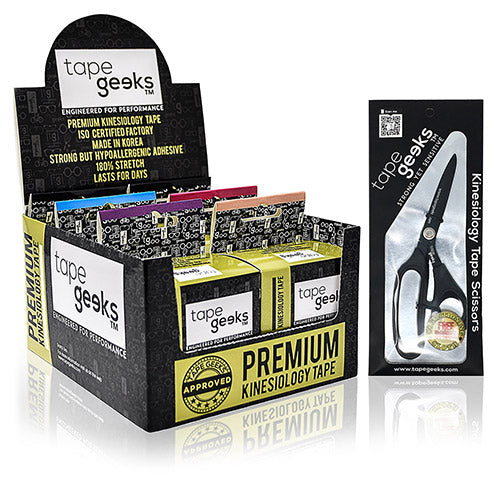
The patella is also known as the kneecap. Derived from Latin, it means small plate and is the bone in front of the knee joint. With a flat and triangular shape, it protects the knee joint from damage.

Shop our kinesiology tape now
Shop NowIf you’re experiencing pain in your patellar and want to know more about it, we’ll be discussing some of the most common injuries in the area. Plus, a kinesiology taping protocol that you can try.
Table of Contents
What are common injuries in the knee?

There are different types of patellar injuries depending on how you injured yourself or what movement was involved. These include:
- Patellofemoral pain syndrome. Patellofemoral pain syndrome (PFPS), also called runner’s knee, is caused by abnormal contact between the kneecap and the thigh bone. It causes pain in the front and under the kneecap.
- Patellar tendonitis.Patellar tendinosis, also known as jumper’s knee, happens when your patellar tendon becomes inflamed. It usually occurs gradually over time, caused by a repetitive motion that includes jumping, running, and kneeling.
- Patellar tendinosis.While quite similar to patellar tendonitis, patellar tendinosis is pain and inflammation in the patellar tendon. However, the pain felt from this condition is persistent and long-lasting, unlike tendonitis which is acute.
Some of the most common causes of patellar tendinosis are overuse of the knee joint, strain in the tendon from sports-related activities.
What are the risk factors for knee pain?

- Being overweight.Having extra weight puts more strain and pressure on the knees. When you put on extra weight, even simple activities like walking or going up and down the stairs can prove strenuous.
- Lack of muscle flexibility or strength.Strong muscles will help you stabilize as well as protect your joints. Having flexible muscles will also allow you a full range of motion.
- Having a previous injury.A past injury on your knee increases your risk of getting a knee injury in the future.
- Engaging in sports that put stress on the knees.Playing sports like basketball, skiing, or running puts more stress on your knees. Even jobs like construction that have repetitive motions increase your risk of knee pain as well.
How do you prevent knee injuries?

Now that you know the most common type of knee injuries, it’s important to know the different ways that you can develop them in the first place. Here are some simple things that you can do to prevent injuries in the knee:
- Always have an adequate warm-up.Make sure to stretch out your muscles before you exercise.
- Wear good shoes. Make sure to replace your worn-out shoes and ensure that you have good traction.
- Maintain a healthy weight.Being overweight puts additional strain on your knees. The extra pounds also increase your risk for osteoarthritis (degeneration of the joint cartilage).
- Use knee guards. Protect your knees for sports that have a high possibility of a knee injury.
- Avoid sudden changes in your exercise intensity.If you’re upping your workout activity, make gradual changes to your exercise routine. This will help your body adjust properly.

Shop our collection now
Shop NowHow do you apply kinesiology tape to the patella?
This taping protocol may also help with discomfort experienced under the kneecap when squatting or when you are running up and down the stairs.
If you’re feeling discomfort when you’re bending your knee - commonly caused by tight quadriceps - this taping technique might be of help, as well.
If you’re new to taping, we highly suggest that you check out our article discussing the basics of kinesiology tape as well as the kin tape tension guidelines that you will be using for an effective application.
- Measure out your tape. The tape should run over the thigh and bring it past the kneecap. Round your edges to prevent premature peeling.
- Line up your tape and make sure your anchor does not have any tension. Hold down the anchor edge. Then, straighten out the rest of the kin tape and bend the patient’s knee into it.
- Rub in the tape to activate the adhesive.
*It’s important to note that the more wrinkles you see on the tape, the better.
Buy skin-friendly Tape Geeks kinesiology tape today

Shop our bundles now
Shop Now
Made from an ISO-certified and dermatologist-approved factory, Tape Geeks tapes are designed with safety and quality in mind. Waterproof, zinc-free, and latex-free, these premium rolls deliver a long-lasting stick without making your skin sick!
Visit the Tape Geeks shop for high-quality tapes that are perfect for active folks who love to move!
Conclusion
If you’ve ever experienced knee pain, you know how uncomfortable it can be to walk or stand. The blog talks about the patellar and other common causes of discomfort and taping protocols that may help alleviate some of your symptoms.
You might also want to check out our other blogs on different muscle groups for more information.
Let us know in the comments what toping protocol you want to learn next!
Get the best deals for Tape Geeks' products by visiting our Amazon store today!

Shop our accessories and more
Shop NowSubscribe to the TapeGeeks Newsletter for new videos, discounts and more!Join The Geeks Club









